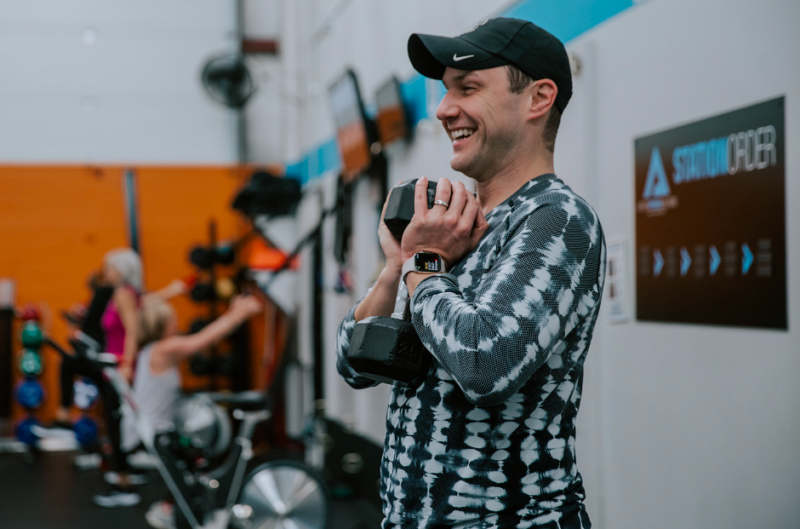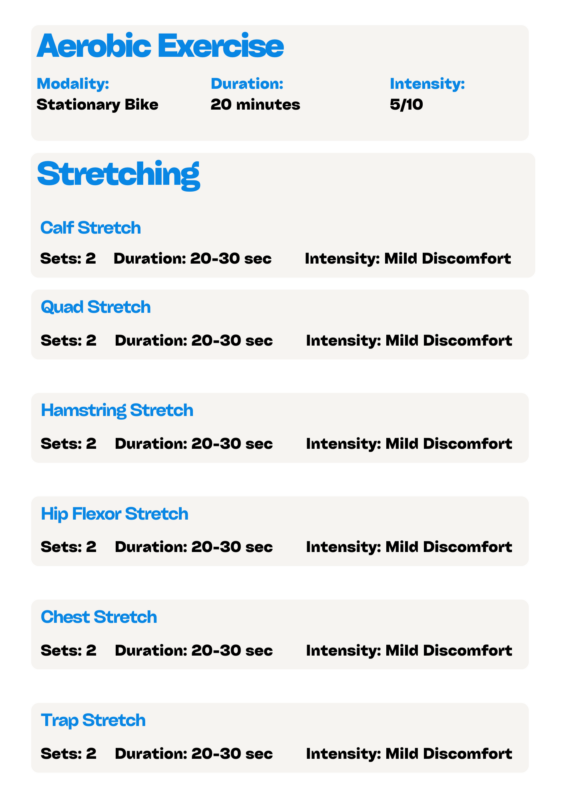High Intensity Interval Training (HIIT) is a very popular mode of exercise, for good reason – it works when done right. The operative part of that sentence is “when done right.” Given our fitfluencer culture where anyone with an Instagram account and good looking physique can seem like an “expert,” it’s time we set the facts straight around this type of exercise. Most importantly, we’ll help determine if it’s right for you, your current abilities, and your goals.
What is HIIT?
Simply put HIIT is a period of higher intensity exercise interspersed with periods of lower intensity exercise (or complete rest). The simplest example of HIIT would be interval training on a treadmill. In this example you’d run at a high intensity for a minute or two work interval (we’ll call this intensity a 9 out 10), then you’d “recover” for a minute at a lower intensity (we’ll call this a 3 out of 10). You’d do this interval for several rounds, repeating the work and recovery combination 10 or more times.
Running is not the only example, you can do this type of work-recovery scheme with cycling, rowing, swimming or even doing low/no load resistance training exercises. When incorporating resistance training exercises, this is typically referred to as HIIT circuit training. HIIT circuit training has been popularized in such commercial settings as CrossFit, Orange Theory, and F45. The popularity of those business models are a testament to the viability for HIIT and HIIT circuit training more specifically. In fact, Applied Fitness Solutions offers HIIT circuit training, tailored appropriately to a wide range of fitness and ability levels.
Benefits of HIIT
 When done properly, for the appropriate type of person, HIIT can be very effective. One of the most obvious benefits is getting more done in less time. A foundational principle of exercise is when you work at a higher intensity you can lower your duration and frequency, and get the same benefit. HIIT certainly provides this benefit. Beyond that, a significant body of research exists that suggests higher intensity exercise, like HIIT training, confers greater benefits than lower intensity exercise. Research has been conducted in areas related to cardiometabolic health, depression, and weight management and found that HIIT training tends to be superior to lower intensity exercise in many cases, with the right type of individuals.
When done properly, for the appropriate type of person, HIIT can be very effective. One of the most obvious benefits is getting more done in less time. A foundational principle of exercise is when you work at a higher intensity you can lower your duration and frequency, and get the same benefit. HIIT certainly provides this benefit. Beyond that, a significant body of research exists that suggests higher intensity exercise, like HIIT training, confers greater benefits than lower intensity exercise. Research has been conducted in areas related to cardiometabolic health, depression, and weight management and found that HIIT training tends to be superior to lower intensity exercise in many cases, with the right type of individuals.
A deep understanding of mechanisms for these improvements are beyond the scope of this article, but let’s explore two potential factors. From a health perspective, a lot of what HIIT training does likely has to do with depleting cellular energy and causing positive inflammation. This kicks off a positive series of events that improve the ability to regulate blood sugar and fight bad inflammation. From a weight management standpoint, HIIT increases something referred to as Excess Post Exercise Oxygen Consumption (or EPOC). EPOC is more generally referred to as the “afterburn,” which are the calories you burn after higher intensity exercise. This elevated calorie expenditure can help better manage weight (along with a healthy diet).
So far, you’re probably thinking HIIT seems like the perfect form of exercise to achieve all your fitness hopes and dreams. Not so fast though, as the old saying goes, if something sounds too good to be true it probably is.
HIIT – A Poor Option for Beginners
Given HIIT’s popularity and effectiveness, it’s no surprise that many people beginning an exercise program consider engaging in HIIT. You might even be one of those people, but beware, HIIT (at best) can be ineffective for beginners and (at worst) can be dangerous. Let’s explore why.
If you’re just beginning an exercise program your fitness level is understandably low. This likely means several of the following things are true:
- Higher Body Fat
- Lower Muscle Mass
- Impaired Muscle Strength
- Reduce Aerobic Capacity
- Limited Flexibility
There’s nothing wrong with all of that, it’s the point at which everyone starts their fitness journey. In fact, if those things weren’t lower than you wanted to be in the first place, you probably wouldn’t start exercising. Furthermore, you may also have one or more medical or orthopedic issues (like high blood pressure, diabetes, lower back pain or a bum knee). This combination of low fitness and possible medical complications makes HIIT training a poor, and even dangerous, choice.
From an effectiveness perspective, for HIIT training to work, two things have to be true. First you physically have to do it and second you have to be able to work at a high enough intensity to achieve the benefits of HIIT. If you are a beginner, it is very important to work with a qualified health and fitness coach who can help determine when and how to integrate HIIT circuit training into your routine.
Why Beginners Struggle to do HIIT
At the risk of being called Captain Obvious if you don’t, or can’t, do HIIT it won’t be effective. Best intentions aside, HIIT is very hard by its nature. Exercise that is very hard requires time to build up to. It requires both a psychological and a biological tolerance. On the psychological level, your brain actually has to get used to higher levels of lactic acid (burning) in your muscle, higher heart rates, higher breathing rates, and soreness after exercise. In general, you need to build the mental muscle to tolerate this. Going from little-to-no exercise to HIIT gives no time to build the mental muscle. Because of this, there is a high likelihood that both consciously and subconsciously your motivation to do HIIT training will wane significantly and very quickly. That is a reality I’ve seen literally thousands of times during my 25+ year career as an exercise physiologist. This is probably a good thing, because if you somehow willed yourself to do it, you might end up in the can’t do it camp, due to an injury.
The flip side of the “don’t do” coin is “can’t do.” This one is much more unfortunate. Someone actually has the mental muscle and motivation to do HIIT, but they can’t do it for one or two reasons. The first reason they might not be able to do it is they’re not fit enough to achieve a high enough intensity during the work interval. On the other hand, they’re likely also not fit enough to keep the recovery interval short enough to get the HIIT benefit. Again, there’s nothing wrong with this, as a low fitness level is expected when someone is just starting their fitness journey. In this particular case the work and recovery intervals are so close together in terms of intensity, you’re just doing steady state exercise. While this isn’t bad, it’s not HIIT, and focusing on a more appropriate program (like we’ll describe below) is a much better use of your time.
The second reason someone can’t do HIIT is much more unfortunate – they get injured doing it. The high intensity nature of HIIT requires muscles and connective tissue to exert and transmit high amounts of force. If muscles and connective tissues aren’t preconditioned enough to do so sprains, strains, and tendonitis can quickly occur. All of this stops an exercise program dead in its tracks. This is an all too common outcome when someone undertakes HIIT without building a good base of fitness first.
A HIIT Alternative for Beginners

Working up to performing HIIT is a great goal, but HIIT is definitely not the starting point for a beginner to safely and effectively begin their first fitness journey. Let’s discuss the evidence-based starting point for beginners and how to progress. Below is an example of how an AFS Health & Fitness Coach may progress a client towards HIIT training.
First and foremost, start with physical activity. Physical activity is defined as “any bodily movement produced by muscles that increases energy expenditure.” Physical activity is literally any movement we do during the day and it is the foundation of a good exercise program to improve health.
Physical activity could be walking, cleaning, playing with your kids/grandkids/pets, dancing, or any movement you enjoy (here’s a great list of different forms of physical activity). The goal here is to accumulate 150 minutes of physical activity each week. This physical activity can be done in bouts of any length. Indeed, 150 one minute bouts is the same as three bouts of 50 minutes from a health perspective. Consider physical activity your foundation. Research suggests that achieving 150 minutes of physical activity each week can significantly reduce mortality and chronic disease, while improving wellbeing and overall health. The great news is, you don’t even need to step a foot into a gym to achieve this. The even better news is that going from very little physical activity to just a little more confers the biggest health benefits.
Physical activity will improve your health, while exercise will improve your fitness. To do this, two primary forms of exercise are required, aerobic and muscle strengthening, and both are equally important. To explain the requirements for these two types of exercise we’ll use the FITT acronym, which stands for Frequency, Intensity, Time, Time.
The beginner FITT for aerobic exercise is as follows:
Frequency: minimum of 2-3 days per week
Intensity: 50-70% of Max Heart Rate (or a 5-7 on an intensity scale of 10)
Time: 20-45 minutes
Type: any rhythmic continuous exercise you enjoy (walking, jogging, biking, swimming, etc.)
The beginner FITT for muscle strengthening is as follows:
Frequency: minimum of 1-2 days per week
Intensity: 3-5 Reps in Reserve (or a 5-7 on an intensity scale of 10)
Time: 1-3 sets or 10-15 reps for all major muscle groups
Type: free weights, machines, body weight, etc.
A simple program that can be performed two days per week, and meets these requirements, can be found below


Take Home Message on HIIT Training
If you’re someone who is a consistent exerciser and has developed a good base of physical fitness in all areas (aerobic fitness, muscle strength, flexibility), has a reasonably healthy body fat percentage, and is free of medical and orthopedic issues, HIIT training could be an option for you. A word of caution for you though, what HIIT provides in terms of a general increase in fitness it lacks in terms of specificity. HIIT isn’t the best type of training if you’re looking to maximize any one aspect of fitness (like aerobic performance, muscle strength, or building muscle).
If you’re a beginner, and just starting your fitness journey, HIIT isn’t the best place to start, in fact it could be a dangerous place to start. You need to take the proper steps to build up your psychological muscle and base of overall physical fitness. This takes time, usually around 12 months of consistent exercise, meeting the FITT guidelines mentioned previously. Taking the time to build this base will result in significant improvements in your fitness, body composition, and overall health. At that point you can decide if HIIT training is a logical progression on your fitness journey.
Not Sure Where to Start
At Applied Fitness Solutions, we know it can be difficult and confusing to go it alone on your journey to take back control of your health. To learn more about how we structure our HIIT program, view our Fitness Solutions Class page that explains it all.
About the Author:
-

On top of overseeing all business development and marketing happenings with the organization, Kemper is supremely passionate about people. He brings his love for our members, his deep appreciation for our team, and his unending passion for life to every interaction and is truly dedicated to cultivating a positive and supportive environment. On any given day you can find Kemper touring new members through the classes, behind the camera on our social pages, and representing us out in the community. The wearer of many metaphorical hats, he doesn’t need a real one because his hair is just as remarkable as his character.
Kemper has served in this role since 2020 and has been with AFS since 2014. He graduated from Eastern Michigan University with a B.S. in Exercise Science and a Minor in Human Nutrition. Kemper also holds the American College of Sports Medicine Certified Personal Trainer Credential, Exercise Physiologist Credential, and the National Strength and Conditioning Association Certified Strength and Conditioning Specialist Certification. His proudest accomplishment to date? Becoming a father to his beautiful daughter Gracie in late 2022.
